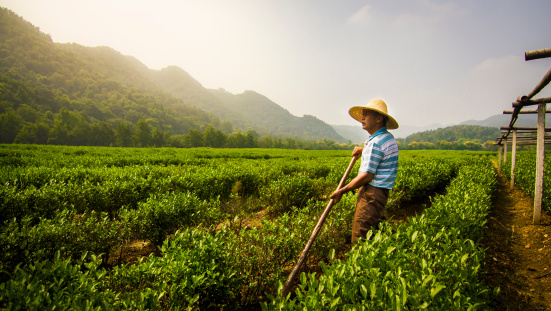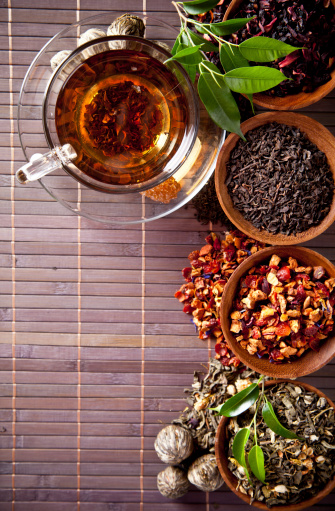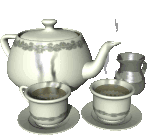Tea is a drink made with dried leaves and boiling water.
Tea leaves are picked from tea bushes.
The leaves are picked by hand.
The leaves are dried.
Tea grows in hot places.
Tea is a drink made by pouring boiling water over dried leaves of the tea plant.
The tea plant is a member of the camellia family of plants. The flowers of the tea plant are small, white and smell sweet. From each flower, three seeds are formed.
Wild tea plants grow to about nine metres tall, but on a plantation (farm) they are pruned (cut) and kept at about waist height to make it easier to pick.
Growing Tea
A worker in a tea plantation. Getty Images
Tea is an evergreen plant that grows in warm, tropical places like Indonesia, India, Sri Lanka and Malaysia. The plants do not produce the necessary shoots in colder places. The best tea is grown on low hills about 900-2000 metres high because the plant grows more slowly in the cooler air, which increases the flavour.
Tea is grown commercially in large farms called plantations. New plants are started from cuttings. After about a year, the 20 centimetre high seedlings are moved to the fields, where over 6,000 plants grow in each hectare.
Within about 4-5 years the plants mature and produce a flush, or growth of new shoots, which are several leaves and a bud. The flushes are picked by hand.
Tea pickers pick about 20 kilograms of leaves each day © Getty Images
Picking the tea
Mechanical harvesters have been developed for flat land, but most teas are picked by hand, mostly by women.
Pickers carrying baskets or sacks on their backs or heads, pluck the leaves from the stems using quick movements. Each one picks about 30,000 shoots in a day, which is about 20 kilograms of leaves that will equal about 5 kilograms of tea when the leaves are processed. In Japan, many tea companies use mechanical picking. After picking, the leaves are taken quickly to villages nearby or to factories on or near the plantation where they are processed.
Processing the tea
There are three main kinds of tea: black, green, oolong. There is now also white and yellow tea. Although all tea comes from the same plant family, the variations include the country and climate where it is grown, the soil type, how it is plucked, whether it is picked early or late in spring, the altitude where the trees are grown, and, importantly, how it is processed.
Tea being processed at a factory. Getty Images
No matter what kind of tea it is, all tea is plucked, sorted, cleaned, dried or withered, and is manufactured according to what its final form will be.
The final stage is oven drying, grading and packing.
Black tea is made by spreading the leaves on shelves called withering racks. Air is blown over them to remove moisture, then they are crushed between rollers to release their juices. They are placed in a fermenting room where the leaves change to a copper colour in controlled humidity, then they are dried in ovens and turn black.
Green tea is made by steaming the leaves in large vats, which prevents them from changing colour. The leaves are then crushed in a machine and dried in an oven.
Oolong tea is made by only partly fermenting the leaves, giving them a greenish black colour.
Read about processing tea
Grades of tea
Tea leaves are graded according to size. The leaves are shaken through screens with different size holes to sort them into sizes. The larger leaves are selected for loose tea and the smallest for tea bags. The tea is packaged into large wooden chests lined with aluminium foil, ready to be transported. Chests of tea are sold at auctions. Teas from different countries or areas each have different tastes and quality. To make the best tea, tea companies blend a number of different teas to develop a particular flavour.
There are many blends of tea. Getty Images
Blended teas
From the earliest times, flavours were added to tea by the Chinese. Processed black, green or oolong teas were used as a base, to which they added flowers, fruits, herbs, spices or essential oils. Jasmine tea is an ancient favourite still popular today.
One favourite blend today is Earl Grey. An essential oil from bergamot fruit is added to a blend of China and Indian teas, giving a faint citrus flavour. Other popular blends are called English breakfast or Irish breakfast (heavier flavours to go with things like bacon or sausage), Afternoon blend (lighter blends of Darjeeling, China, Sri Lankan teas with things like jasmine or bergamot), Lapsang Souchong or Russian Caravan (heavy smoky blend of black teas with hints of orange and cloves).
A Chinese legend about the discovery of tea
A Chinese Emperor ordered everyone to drink boiled water for their health.
One day, as the water for his drink was boiling, some leaves from a nearby tree fell into the pot. When the Emperor drank the water he was overjoyed with this new drink, which he named 'tea'.







